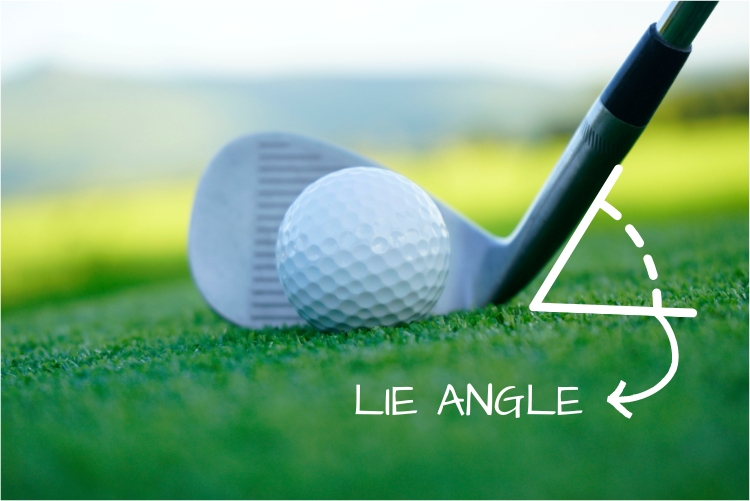Golf Club Lie Angle Explained for Beginners
If you were to ask most golfers what the “lie angle” is on their golf clubs, many would look at you with confusion.
Lie angles are the angle formed between the shaft and the ground when the club is at address.
Finding the true lie angle of your clubs, especially if you are a right handed golfer, helps create that custom fit that helps players hit the ball with authority.
In this guide to the golf club lie angle, we’ll look at why this measurement matters and how golfers can improve the quality of their contact by finding the right lie angle for their golf clubs.
Table of Contents
CHAPTER 1
Types of Lie Angles
Standard Lie Angle
A balanced lie angle in golf is a setting that is neither too flat nor too high but is set at a standard angle that is suitable for most players.
Ideal lie angles for players with their irons will vary depending on the individual golfer and their swing characteristics.
Short irons, for example, with a balanced angle upon entry into the turf will make it easier for a golfer to strike the shot with a square face, which is essential for achieving crisp, productive shots.
Flatter Lie Angle
A flatter lie angle in golf refers to an angle less than the standard angle for a golf club. An iron set with a flatter lie angle will have the shaft closer to the turf than an iron with a standard lie angle.
A flatter angle can make it difficult for a golfer to strike the golf ball with a square clubface, leading to shots that tend to slice or fade.
An iron with a flatter lie angle may be advantageous for players with a steep swing plane who need to prevent the clubhead from digging into the grass.
Upright Lie Angle
An upright lie angle between the shaft and the soil means that the shaft provides a higher degree of distance between the shaft and ground than standard lie angles.
These more upright clubs may benefit a golfer who has a shallow swing plane with their game and needs to prevent the clubhead from hitting the ground too early in the swing.
CHAPTER 2
How to Find the Proper Golf Club Lie Angle
To find the proper lie angle with your irons in golf, you can try the following steps:
1. Take a few practice swings with your iron to get a feel for its current setup.
Pay attention to where the clubhead contacts the turf and how the clubface hits the ball.
Too much toe in your divots means you need a flatter lie angle, while too much heel can indicate a more upright shaft angle is necessary for better contact.
2. Try out different lie angles to see which one feels the most comfortable and allows you to strike the golf ball with a square clubface.
You can experiment with both flat and upright lie angles to see how they affect your shots during practice or with a coach.
3. Take swings with a launch monitor.
The monitor can also check your lie angle with your longer irons, making it an excellent tool for finding out if your swing needs adjustment.
CHAPTER 3
Frequently Asked Questions
What lie angle should my golf clubs be?
Most amateur golfers get by just fine with a standard lie angle to their club set.
However, if your lie angles on your clubs are causing you to experience uneven divots, where the toe or the heel of the iron digs into the soil more heavily, then you should consider a slight adjustment of your lie angle with a club fitter.
The ideal lie angle for your golf clubs will depend on your swing and body type.
A professional club fitter or golf instructor can help you determine the ideal lie angle for your clubs based on your height, arm length, and swing plane.
In general, a lie angle that is too flat or too upright can cause problems with your swing and lead to strikes that tend to slice or fade.
How do I know if my lie angle is correct?
The best way to find the correct lie angle for your clubs is to experiment with different settings and see how they affect your shotmaking.
Lie angles checked during club fitting can also help you ensure the club’s toe isn’t higher than the heel, and the sole sits flush with the surface.
Your lie angle can be corrected by subtracting or adding length to your irons’ shaft. If you are tall and find that your impact point too often finds the toe, then chances are your shafts are too short.
What happens if my lie angle is too upright?
If your lie angle is too upright with your new clubs, it can cause a few problems with your swing.
First, it can make it easier for the clubhead to catch the ground too early in the swing, leading to a shot that tends to slice.
Second, it can cause the clubface to open too much at impact, leading to shots that tend to fade or hook.
Finally, it can make it difficult to square the clubface at impact, which is essential for achieving accuracy. In general, a lie angle that is too high can cause inconsistency in your shots and make it difficult to control the shot.
If you play with the same length irons, the angle of your clubs will remain consistent throughout the set.
What does a flatter lie angle do?
A flat lie angle signals that the shaft is closer to the turf, causing your divots to feature more heel. Some players utilizing flat lie angles will find that most of their balls go to the target line’s left after hitting their shot.
For taller players, flatter lie angles can really cause problems because usually, that signifies an imbalanced swing.
For shorter golfers playing shorter clubs, the flatter lie can actually work to their advantage, allowing them to create more consistent contact with their golf equipment.
A flatter lie angle can help to prevent the clubhead from digging into the ground too much during the swing.
This can be beneficial for weekend warriors with a steep swing plane who tend to hit the turf before the ball, leading to shots that tend to push or slice.

